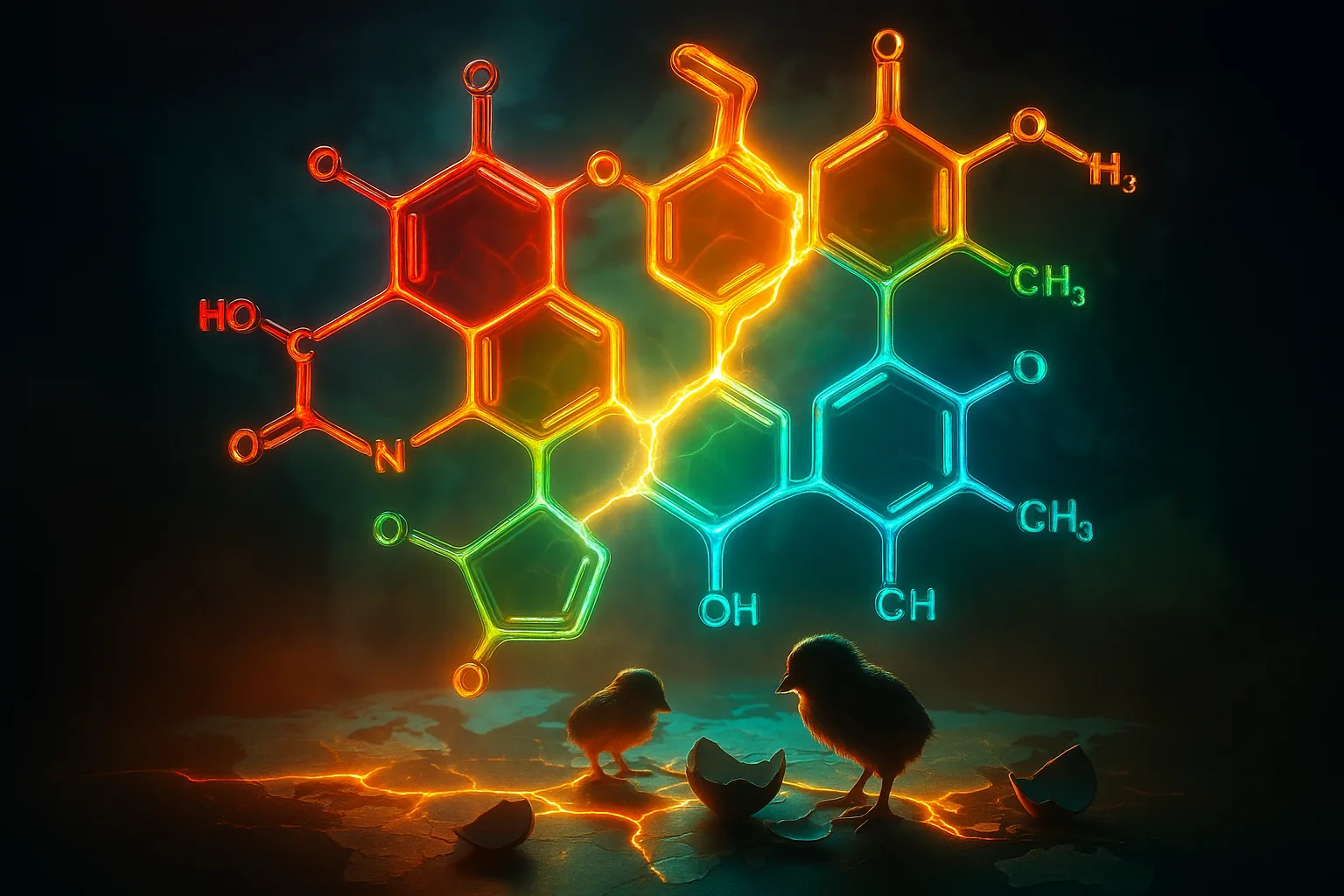Mycotoxins in Poultry Feed and Their Hidden Toll on Global Production

Mycotoxins—toxic secondary metabolites produced by certain species of filamentous fungi—are among the most pervasive, yet often underestimated, threats to modern poultry production systems. These invisible contaminants are primarily produced by three genera of fungi: Aspergillus, Fusarium, and Penicillium. They infiltrate feed ingredients at multiple stages: during crop growth in the field, or later during storage under suboptimal conditions such as high humidity or poor ventilation.
Global surveys reveal a sobering reality: 81% of animal feed samples contain at least one mycotoxin, with 52% of European and Mediterranean feed samples contaminated by multiple toxins simultaneously. Despite their microscopic size and lack of visible signs, mycotoxins can cause devastating economic losses, exceeding £150,000 annually for medium-scale poultry operations and reducing feed efficiency by up to 10%.
The impact of these toxins extends far beyond economics. They compromise animal health and welfare, reduce food safety standards, and undermine environmental sustainability, making them a multidimensional threat that demands urgent and coordinated attention across agricultural, scientific, and policy sectors.
Mycotoxin Diversity: A Complex Web of Toxicity
Major Culprits and Their Biological Targets
Poultry are exposed to a wide range of structurally diverse mycotoxins, each with unique mechanisms of action and pathogenic effects:
| Mycotoxin | Primary Fungi | Target Organs | Clinical Effects |
|---|---|---|---|
| Aflatoxin B1 (AFB1) | Aspergillus flavus, A. parasiticus | Liver | Hepatotoxicity, fatty liver degeneration, immunosuppression, reduced egg production, increased susceptibility to infections |
| T-2 Toxin | Fusarium sporotrichioides, F. langsethiae | Oral cavity, Gizzard | Oral ulcers, necrotic lesions, gizzard erosion, feed refusal, hemorrhagic syndrome |
| Ochratoxin A (OTA) | Aspergillus ochraceus, Penicillium verrucosum | Kidneys | Nephrotoxicity, renal dysfunction, decreased eggshell quality, polydipsia |
| Fumonisin B1 (FB1) | Fusarium verticillioides, F. proliferatum | Lungs, Liver | Pulmonary edema, hepatic damage, altered lipid metabolism, increased liver-to-body weight ratio |
| Deoxynivalenol (DON) | Fusarium graminearum, F. culmorum | Intestines | Gut inflammation, “leaky gut” syndrome, reduced nutrient absorption, impaired performance |
| Zearalenone (ZEA) | Fusarium graminearum, F. culmorum | Reproductive system | Estrogenic effects, reproductive disorders, reduced hatchability and fertility |
Each toxin affects poultry differently, but collectively they create a toxic cocktail that can lead to chronic illness, reduced productivity, and even mortality.
The Synergy Threat: When 1 + 1 = 3
One of the most dangerous aspects of mycotoxin exposure is synergistic toxicity—where combinations of toxins produce more severe effects than the sum of individual exposures:
- Aflatoxin B1 + Ochratoxin A: Together, they cause 10 times greater kidney damage than either toxin alone.
- T-2 toxin + DON: Combined, they severely suppress immune function, increasing vulnerability to infectious diseases.
- DON + ZEA + Fumonisins: At low levels, this trio has been linked to skeletal abnormalities like tibial dyschondroplasia in broilers.
This interaction means that even low-level contamination can have significant biological consequences, challenging traditional risk assessment models based on single-toxin thresholds.
Economic and Environmental Repercussions: The Hidden Bill
Productivity Losses and Financial Drain
Mycotoxins silently erode profitability through multiple pathways:
- Reduced feed efficiency: By damaging the intestinal lining and impairing nutrient absorption, toxins like DON and fumonisins increase feed conversion ratios (FCR) by 5–20%.
- Reproductive compromise: Mycotoxins like ZEA and OTA interfere with hormonal balance and calcium metabolism, leading to reduced egg production, thinner shells, and lower hatchability.
- Increased mortality: Chronic exposure to aflatoxins raises flock mortality by 3–5%, while fumonisins spike death rates in young birds due to acute pulmonary edema.
According to a comprehensive study by Queen’s University Belfast, mycotoxins cost an average poultry operation over £150,000 per year in lost productivity, veterinary costs, and culling expenses.
Carbon Footprint Amplification
Beyond financial loss, mycotoxins also sabotage environmental sustainability:
- Inefficient feed utilization caused by mycotoxin-induced digestive damage increases the carbon footprint of poultry production by over 8%, due to extended grow-out periods and higher feed input requirements.
- Globally, 1.2 million tons of grain are wasted annually due to mycotoxin contamination or feed refusal, contributing to both food insecurity and unnecessary resource use.
This makes mycotoxin management not only a profitability issue, but also a climate and food security imperative.
Detection Challenges: The Masked Enemy
Limitations of Conventional Methods
Traditional methods of mycotoxin detection face critical shortcomings:
- ELISA tests, commonly used in the field, detect only free (unbound) mycotoxins, missing masked forms—those conjugated to sugars or proteins—which may be released during digestion and become toxic post-ingestion.
- Many ELISA kits have detection limits above 0.2 ppm, which may not capture subclinical effects occurring at much lower concentrations.
Next-Generation Analytics
Advances in analytical technology offer more precise tools for early detection and risk mitigation:
| Method | Detection Limit | Masked Mycotoxin Detection | Cost & Accessibility |
|---|---|---|---|
| ELISA | >0.2 ppm | No | Low cost, field-deployable |
| HPLC (High-Performance Liquid Chromatography) | <0.05 ppm | Limited | Moderate cost, lab-based |
| LC-MS/MS (Liquid Chromatography-Tandem Mass Spectrometry) | <0.01 ppm | Yes | High cost, gold standard |
| Rapid biosensors | Varies | Emerging | Portable, real-time results |
LC-MS/MS is now considered the gold standard for comprehensive mycotoxin screening, capable of detecting over 100 mycotoxins simultaneously, including masked forms. However, its high cost and technical complexity limit its use outside of research or large commercial labs.
New developments in real-time biosensors and IoT-enabled monitoring systems promise to bring advanced diagnostics to the farm level, enabling proactive decision-making before contamination becomes a crisis.
Mitigation Strategies: From Prevention to Detoxification
Pre-Harvest Interventions
The best defense begins in the field:
- Crop rotation and agronomic practices: Reducing plant stress through proper irrigation, insect control, and planting resistant hybrids helps minimize fungal infection.
- Biological control agents: Non-toxigenic strains of Aspergillus flavus can outcompete toxigenic strains, significantly reducing aflatoxin contamination in crops like corn and peanuts.
Post-Harvest Management
Proper handling and storage are crucial to preventing mold proliferation:
- Moisture control: Keeping grains below 14% moisture content inhibits fungal growth.
- Temperature regulation: Storing feed at below 15°C slows mold development.
- Use of preservatives: Organic acids like propionic acid and acetic acid effectively inhibit mold in stored grains and feed.
In-Feed Detoxification
When contamination occurs, several strategies can mitigate harm:
- Adsorbents: Clay minerals like bentonite and zeolite bind aflatoxins effectively but are less effective against polar toxins like DON and fumonisins.
- Biotransformation: Enzymatic degradation using microbes like Eubacterium BBSH 797 or engineered enzymes can convert toxins into non-toxic metabolites.
- Immunomodulation and Antioxidants: Nutrients like vitamin E, selenium, and glutathione precursors help counteract oxidative stress caused by mycotoxins, supporting liver and immune function.
Combining adsorption, biotransformation, and nutritional support provides a multimodal defense against mycotoxin impacts.
Case Study: Lessons from the Field – Argentina Broiler Outbreak (2023)
A recent outbreak in Argentine broiler farms highlights the hidden dangers of mycotoxin exposure:
- Symptoms observed: Unexplained 10% drop in weight gain, 8% increase in FCR, with no obvious clinical signs of disease.
- Diagnosis: Routine ELISA testing found nothing abnormal. However, LC-MS/MS analysis revealed masked DON (3.2 ppm) and fumonisin B1 (12 ppm)—toxins undetectable by conventional methods.
- Solution: Switching to a broad-spectrum mycotoxin deactivator containing enzymes, adsorbents, and antioxidants restored performance within just 14 days.
This case underscores the importance of advanced diagnostics and integrated detoxification strategies in managing mycotoxin risks.
Future Perspectives: Innovation Horizons
Emerging technologies are reshaping the fight against mycotoxins:
- Digital Monitoring Systems: IoT sensors in silos track temperature, humidity, and carbon dioxide levels, predicting mold hotspots in real time.
- CRISPR-Edited Crops: Researchers have developed genetically modified corn lines with silenced fumonisin biosynthesis genes, resulting in 98% reduction in toxin production.
- Precision Binders: Engineered nanoclay composites can target specific mycotoxins with high affinity, improving detoxification efficacy.
- AI-Powered Risk Forecasting: Machine learning models analyze climate data to predict regional mycotoxin outbreaks, enabling proactive interventions.
As Dr. Gerd Schatzmayr of DSM-Firmenich emphasizes:
“In an era of climate volatility and global trade disruptions, effective mycotoxin risk management isn’t optional—it’s foundational to profitability, sustainability, and food security.”
From Awareness to Integrated Defense
Mycotoxins represent a silent but powerful adversary in global poultry production. Their ability to suppress immunity, amplify disease, and stealthily drain profitability demands a paradigm shift in how the industry approaches feed safety and animal health.
The solution lies in Integrated Mycotoxin Management (IMM)—a holistic approach combining:
- Preventive Agronomy: Drought-resistant crops, biocontrol agents, and smart farming practices.
- Advanced Diagnostics: Adoption of LC-MS/MS, biosensors, and digital monitoring for early detection.
- Multimodal Detoxification: Use of adsorbents, biotransformers, and nutritional support to neutralize toxins and protect animal health.
With climate change accelerating fungal proliferation, and global trade increasing exposure risks, the poultry industry must treat mycotoxins not as a sporadic nuisance, but as a persistent biosecurity priority.
As science and innovation continue to unveil novel solutions, one truth remains clear: Vigilance against these invisible toxins is the price of sustainable poultry production.
